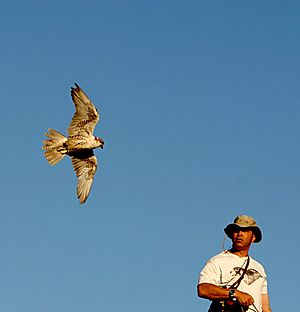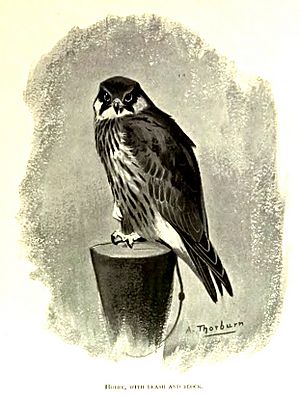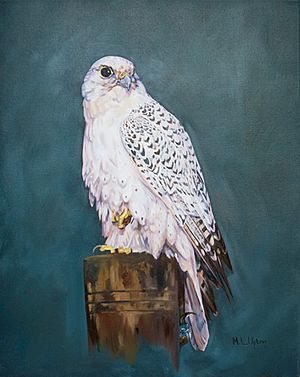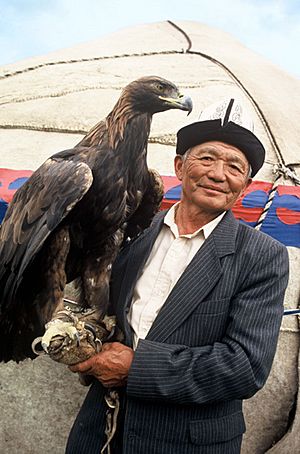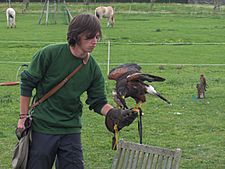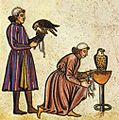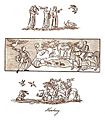Falconry facts for kids
Falconry is a special art or sport. It involves using trained birds of prey to hunt wild animals for people. These birds are also called raptors.
People who practice falconry are called falconers. If they fly a falcon, they are a falconer. If they fly a hawk, they are an austringer. Today, the Red-tailed Hawk and the Harris's Hawk are often used. The words "hawking" and "hawker" are now mostly used for street sellers. So, "falconry" and "falconer" describe everyone who uses trained birds of prey to hunt.
Contents
History of Falconry
Many believe falconry began in Mesopotamia, a very old region. Others think it started in the Far East. The first signs of falconry are from around 722-705 BC. This was during the time of King Sargon II.
Falconry likely came to Europe around AD 400. This happened when groups like the Huns and Alans arrived from the East. Frederick II, a European ruler, became very interested in falconry. He learned about Arabic falconry during his travels. He even had a book about falconry translated into Latin. He made his own changes to the book in 1241. This resulted in his famous book, De Scientia Venandi per Aves.
In the Middle Ages in Europe and feudal Japan, falconry was a popular sport. It was also a sign of high social status. In Japan, this sport was called takagari. Eggs and young birds of prey were rare and costly. Training a hawk or falcon needed a lot of time, money, and space. Because of this, only noble families could usually afford it.
In Japan, there were strict rules about who could hunt which animals. These rules depended on a person's rank within the samurai class. Even after falconry became less popular, it stayed a status symbol in art and stories. Pictures of eagles or hawks could represent a noble person. They showed someone noble and fierce. Even wealthy commoners could buy art showing falcons. This allowed them to feel a connection to this noble sport.
Birds Used in Falconry
Many types of raptors can be used in falconry. Falconers group them into different categories:
- Broadwings: These include Eagles, Buzzards, and the Harris's Hawk.
- Longwings: This group mainly includes Falcons.
- Shortwings: These are mostly Accipiters.
Osprey (Pandion)
The Osprey is a medium-large bird found all over the world. It mostly eats fish. Generally, ospreys are not used in falconry. However, the idea of using a falcon to catch fish is still interesting to some.
Sea Eagles (Haliaëtus)
Most species of Haliaëtus mainly catch and eat fish. But in places where they are not protected, some have been used to hunt animals on the ground.
True Eagles (Aquila)
The Aquila group of eagles is found almost everywhere. The stronger types are sometimes used in falconry. For example, Golden Eagles have been used to hunt wolves in Kazakhstan. Today, Kazakh eagle hunters use them to hunt foxes and other large animals. This also happens in nearby Kyrgyzstan. Most eagles hunt on the ground, but they can sometimes catch birds. Eagles are not as widely used in falconry as other birds. This is because larger eagles often hunt only in big open areas. They can also be more dangerous to people in crowded places. Training and managing an eagle is also very difficult.
Buzzards (Buteo)
The Buteo group is known as hawks in North America. They are found worldwide, especially in North America. The Red-tailed Hawk, Ferruginous Hawk, and sometimes the Red-shouldered Hawk are used in falconry today. The Red-tailed Hawk is strong and can hunt many different animals. It can catch rabbits, hares, and squirrels. In the right conditions, it can even catch geese, ducks, pheasants, and wild turkeys. The Red-tailed Hawk is also a good bird for beginners. The Eurasian or Common Buzzard is also used. However, it needs more effort to train for hunting rabbits.
Harris's Hawk (Parabuteo)
The Parabuteo unicinctus is the only bird in this group worldwide. Many consider the Harris's Hawk to be the best raptor for hunting rabbits or hares. It is also good at catching birds. Harris's Hawks are often bred in captivity. They are very popular because of their calm nature and hunting skills. They are also social birds, which is rare for raptors. Harris's Hawks can hunt in groups, just like they do in the wild. This bird is native to the Americas, from southern Texas to northern South America.
True Hawks (Accipiter)
The Accipiter group of hawks is found all over the world. A hawk expert once said that accipiters attack "extremely swift, rapid and violent." They are well known in falconry in both Europe and North America. The goshawk has been trained for falconry for hundreds of years. It can hunt many different birds and mammals.
Falcons (Falco)
The Falco group of birds is found worldwide. Many falconry activities involve species from this group. Most falcons hunt other birds. The Peregrine Falcon, for example, hunts almost only birds.
Owls (Strigidae)
Owls are not closely related to hawks or falcons. Old falconry books do not talk much about using owls. However, at least two species have been used successfully. These are the Eurasian Eagle Owl and the Great Horned Owl.
Training owls is quite different from training hawks and falcons. Owls use their hearing more than their sight to hunt. They can only see in black and white and are far-sighted. This sometimes makes falconers think owls are less smart. Owls can be easily distracted by new sounds and do not respond to food signals as quickly. But if trained well, owls show the same level of intelligence as hawks and falcons.
Images for kids
-
Indian king, Maharaja Suraj Mal of Bharatpur with a hawk
-
A lady with a peregrine falcon on a horse
-
A lanner falcon with its lure
-
A barn owl landing on a falconer's hand
-
A Mongolian man with his golden eagle before a contest
-
A brown falcon used for falconry in Tasmania
-
A saker falcon used for falconry in Qatar
See also
 In Spanish: Cetrería para niños
In Spanish: Cetrería para niños


